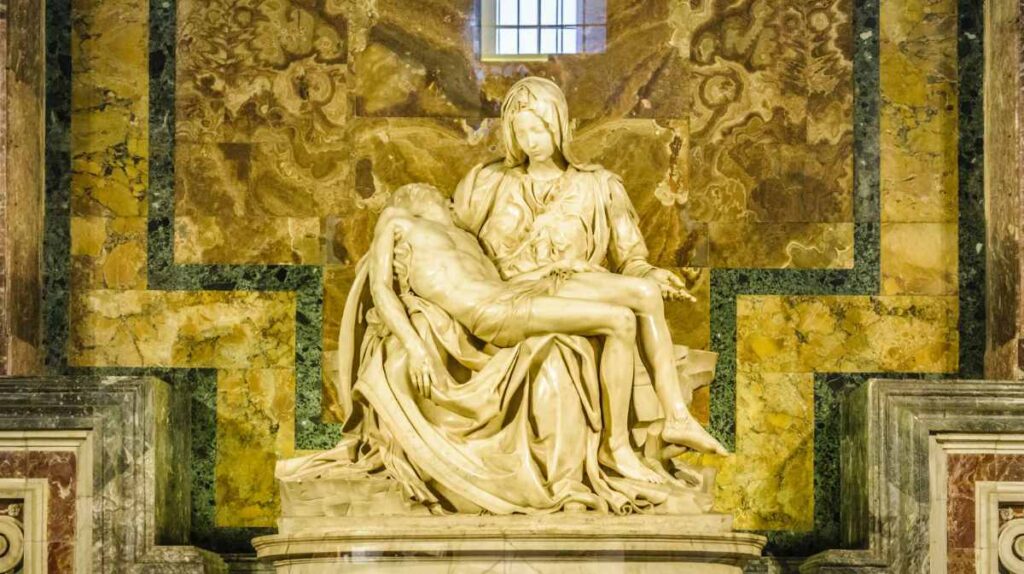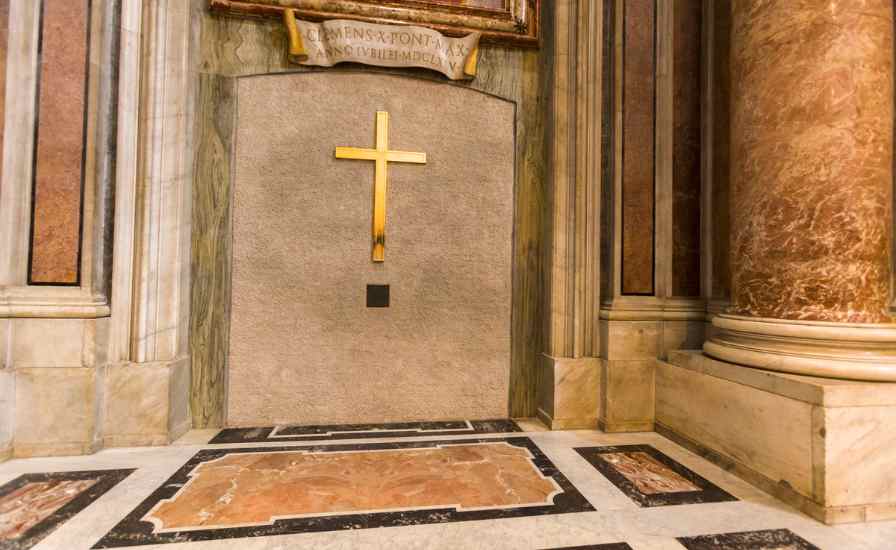What Are the Most Famous Artworks Inside St. Peter’s Basilica?

Introduction
Discover the must-see artworks inside St. Peter’s Basilica. Plan your tour with our guide to Michelangelo, Bernini, and more in this iconic Vatican landmark.
Tools
Supplies
Discover the must-see artworks inside St. Peter’s Basilica. Plan your tour with our guide to Michelangelo, Bernini, and more in this iconic Vatican landmark.
Most Famous Artworks Inside St. Peter’s Basilica
When you think of Vatican City, the majestic image of St. Peter’s Basilica probably comes to mind. It’s not just a cornerstone of Catholic faith but also a treasure trove of some of the world’s most remarkable artworks. If you’re planning a visit or considering a St. Peter’s Basilica tour, you’re in for an artistic feast. Whether you opt for a St. Peter’s Basilica self-guided tour or the St. Peter’s Basilica dome tour, this iconic site promises an unforgettable journey through art and history.
Michelangelo’s Pietà

One of the most captivating pieces inside St. Peter’s Basilica is Michelangelo’s Pietà. This stunning sculpture, located near the entrance, captures the sorrow and serenity of the Virgin Mary cradling the lifeless body of Jesus. Michelangelo completed this masterpiece when he was just 24 years old, and it remains one of the finest examples of Renaissance art. The delicate details and emotional depth of the Pietà are sure to leave a lasting impression.
The Baldachin by Bernini
As you walk further inside St. Peter’s Basilica, your eyes will be drawn to the grandiose Baldachin, or Baldacchino, designed by Gian Lorenzo Bernini. This massive bronze canopy stands over the high altar and the tomb of St. Peter. Completed in 1634 , it’s an extraordinary blend of sculpture and architecture. The twisted columns, rich with intricate designs, elevate the space’s grandeur, making it a focal point of your visit. Bernini’s Baldachin is not just a structure; it’s a symbol of the basilica’s magnificence.
The Dome of St. Peter’s Basilica
Any St. Pete Basilica dome tour will highlight the architectural and artistic brilliance of Michelangelo, who designed the dome. Although he passed away before its completion, his vision was brought to life by his successors. The dome’s interior is adorned with mosaics and Latin inscriptions that pay homage to the apostles and saints. Climbing to the top is an adventure itself, offering breathtaking views of Vatican City and Rome. Don’t miss this part of your St. Peter’s Basilica tour—it’s both a spiritual and visual highlight.
The Chair of St. Peter

Another Bernini masterpiece inside St. Peter’s Basilica is the Chair of St. Peter (Cathedra Petri). This stunning bronze sculpture, which encases a wooden chair traditionally believed to have been used by St. Peter himself, is located in the apse. Bernini’s work depicts four Doctors of the Church supporting the chair, with angels and a golden stained-glass window featuring the Holy Spirit in the form of a dove above it. This piece represents the authority and continuity of the papacy.
The Tomb of Pope Alexander VII
Bernini’s influence is profound inside St. Peter’s Basilica, and another of his notable works is the Tomb of Pope Alexander VII. Located in the south transept, this monument is an intricate blend of marble, bronze, and jasper. It features a lifelike statue of the pope in prayer, supported by figures representing virtues like charity and truth. A striking skeleton holding an hourglass emerges from beneath a shroud at the base, symbolizing the fleeting nature of life.
St. Peter’s Square and the Facade

While technically outside the basilica, St. Peter’s Square and the facade should not be overlooked. Designed by Bernini, the square’s colonnades create a welcoming embrace. The facade, completed by Carlo Maderno, features statues of Jesus, John the Baptist, and the apostles. As you approach the basilica, the sheer scale and beauty of the square and facade set the tone for the treasures awaiting inside.
The Nave and Main Altar
Walking through the nave, you’ll be struck by the vastness and the intricate details of the floor mosaics and the coffered ceiling. The main altar, situated beneath Bernini’s Baldachin, is where only the pope can celebrate mass. The high altar is built over the site believed to be St. Peter’s tomb, making it the spiritual heart of the basilica.
The Crypt and Grottoes

For a different perspective on the basilica’s history, explore the crypt and grottoes below the main floor. This area houses the tombs of many popes, including St. Peter. The grottoes are an essential stop on a St. Peter’s Basilica self-guided tour, offering a serene and reflective space away from the grandeur above.
The Cupola and Panoramic Views
No visit is complete without ascending to the top of the dome. The cupola climb is part of the St. Pete Basilica dome tour and provides panoramic views of Vatican City and beyond. As you ascend, you’ll see the interior of the dome up close, including the beautiful mosaics and inscriptions. Once at the top, the view is simply breathtaking, offering a unique perspective of Rome’s skyline.
The Chapels and Side Altars
St. Peter’s Basilica is home to numerous chapels and side altars, each adorned with beautiful artworks and relics. The Chapel of the Blessed Sacrament, designed by Carlo Maderno and decorated by Bernini, is a serene space for prayer and reflection. The Chapel of St. Sebastian houses the tomb of Pope John Paul II, a site of pilgrimage for many visitors.
The Treasury Museum
Inside St. Peter’s Basilica, there is also the lesser-known but equally fascinating Treasury Museum. This museum houses a collection of sacred relics, liturgical objects, and historical artifacts that span the history of the Catholic Church. Items such as papal tiaras, vestments, and religious artifacts provide a glimpse into the rich traditions and ceremonies of the papacy. The Treasury Museum is a must-visit for those interested in the ecclesiastical history and the opulence associated with the Vatican.
The Baptistery
The Baptistery inside St. Peter’s Basilica is another hidden gem. Located in the first chapel on the right as you enter, this space is dedicated to St. John the Baptist. It features a stunning baptismal font and beautiful frescoes depicting scenes from the life of St. John. The Baptistery is a serene and reflective space, perfect for contemplating the sacrament of baptism and its significance in the Christian faith.
The Monuments to Popes

As you walk through St. Peter’s Basilica, you will notice numerous monuments and tombs dedicated to various popes. These monuments are often grand and elaborate, reflecting the status and contributions of these leaders of the Catholic Church. Notable examples include the Monument to Pope Gregory XIII, which features an intricate statue of the pope, and the Monument to Pope Clement XIII, crafted by the famous sculptor Antonio Canova. Each of these monuments tells a story of the pope’s reign and their impact on the Church.
The Altar of the Transfiguration
Another notable altar inside St. Peter’s Basilica is the Altar of the Transfiguration. This altar features a stunning mosaic reproduction of Raphael’s famous painting, “The Transfiguration“. The original painting is housed in the Vatican Museums, but the mosaic in the basilica is a faithful and breathtaking representation. The artwork depicts the biblical event of Jesus’ transfiguration, showcasing Raphael’s masterful composition and vibrant use of color.
The Vatican Grottoes
Beneath St. Peter’s Basilica lies the Vatican Grottoes, a vast and fascinating area that serves as the final resting place for many popes and significant religious figures. The grottoes include the tomb of St. Peter, making it a place of profound spiritual importance. Visitors can explore this subterranean world, marvel at the ancient sarcophagi, and pay respects to the numerous pontiffs buried there. The quiet and reflective atmosphere of the grottoes provides a stark contrast to the grandeur above, offering a moment of contemplation and reverence.
The Holy Door

One of the unique features of St. Peter’s Basilica is the Holy Door, or Porta Sancta, which is only opened during a Jubilee year. Located to the right of the main entrance, the Holy Door symbolizes the passage to salvation and is a significant aspect of Catholic tradition. When opened, pilgrims passing through the door are granted a plenary indulgence. The last opening of the Holy Door was in 2015 for the Jubilee Year of Mercy, a practice that continues to draw thousands of pilgrims from around the world.
The Gardens of Vatican City

While not directly inside St. Peter’s Basilica, the Vatican Gardens offer a serene escape from the bustling crowds. These beautifully landscaped gardens cover nearly half of Vatican City and are filled with fountains, sculptures, and rare botanical species. A guided tour of the Vatican Gardens can be a perfect complement to your visit to St. Peter’s Basilica, providing a peaceful environment to reflect on the grandeur and spiritual significance of what you have seen.
Practical Information for Visitors
Here are some additional practical tips to enhance your visit:
Tickets and Entrance: While entrance to St. Peter’s Basilica is free, certain areas like the Treasury Museum, the dome climb, and the Vatican Grottoes require a ticket. Booking these tickets in advance can save you time.
Audio Guides and Apps: For those on a St. Peter Basilica self-guided tour, audio guides and mobile apps can be incredibly helpful. They provide detailed information about the artworks and architecture, ensuring you don’t miss out on any significant details.
Accessibility: The basilica is accessible to visitors with disabilities. There are ramps and elevators to accommodate wheelchairs, and the staff are generally very helpful.
Photography: Photography is allowed inside St. Peter’s Basilica, but the use of flash and tripods is prohibited. Be respectful of the sacred atmosphere, especially during services and masses.
Visiting Tips for Art Enthusiasts
To make the most of your visit inside St. Peter’s Basilica, here are some tips:
Plan Ahead: If possible, book a St. Peter Basilica tour to gain deeper insights into the artworks and history. Guided tours often include priority access, saving you time.
Self-Guided Tours: For a more flexible experience, consider a St. Peter Basilica self-guided tour. Vox City App is available to help you navigate the basilica at your own pace.
Early Start: Arrive early to avoid the crowds, especially if you want to spend time appreciating the details of each artwork.
Dress Code: Remember to dress modestly, as the basilica is a place of worship. Shoulders and knees should be covered.
Climbing the Dome: If you plan to do the St. Peter’s Basilica dome tour, be prepared for a bit of a climb. The views are worth the effort, but comfortable shoes are a must.
The Art of St. Peter’s Basilica: A Timeless Experience
The artworks inside St. Peter’s Basilica are not just decorations; they are narratives of faith, history, and artistic genius. Each piece tells a story, inviting visitors to connect with the past and the spiritual significance of this sacred space. Whether you’re an art enthusiast, a history buff, or someone seeking a deeper connection to your faith, the basilica offers an unparalleled experience.
As you walk through the grand halls, past centuries-old sculptures and breathtaking mosaics, you’ll find that every corner of St. Peter’s Basilica holds a piece of the world’s artistic heritage. The beauty of the basilica lies not just in its individual artworks but in the harmonious blend of art, architecture, and spirituality that it represents.In conclusion, a visit to St. Peter’s Basilica is more than just a tour—it’s a journey through time, art, and faith. Whether you choose a guided tour, a self-guided exploration, or the exhilarating dome climb, the basilica promises an experience that will stay with you long after you’ve left its grand halls. So, pack your bags, grab your camera, and get ready to immerse yourself in the timeless beauty inside St. Peter’s Basilica.